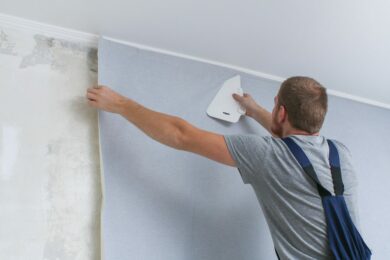A wallpaper is a timeless interior design solution and has the power to completely transform a room’s look and feel. It’s more than just a covering for walls; a wallpaper is an expression of your style and personality. Check this guide to learn all about the wallpaper tools you should use and the step-by-step process of putting it up.
See also: Types of wallpaper: Materials, designs, pros and cons
What is a wallpaper?
A wallpaper is a covering used to decorate and enhance the appearance of interior walls. It comes in various patterns, textures and colours and is applied to walls to add a visual element to a room’s décor. Wallpaper serves both functional and aesthetic purposes, offering an alternative to plain painted walls and allowing individuals to personalise their living spaces according to their preferences. Whether you opt for classic florals, contemporary geometrics or intricate damasks, wallpaper has the ability to create a visually stunning impact in any room.
Wallpaper tools to use
- Wallpaper adhesive or paste
- Measuring tape
- Wallpaper smoothing brush or plastic smoother
- Wallpaper knife or scissors
- Wallpaper brush or roller
- Sponge
- Level
- Water bucket
How to put up a wallpaper?

Gather wallpaper tools and materials
Before you begin, ensure you have all the necessary tools and materials ready to go. This will make the process easier and prevent interruptions.
Determine how much wallpaper you need
Measure the height and width of each wall you plan to wallpaper. Calculate the area required and purchase a little extra for allowances and matching patterns.
Prepare the surface
- Ensure the wall surface is clean, smooth and free from any imperfections.
- Patch up any holes or cracks and sand the surface if needed.
Make a guide for your first wallpaper strip
Use a level and draw a vertical line along the wall’s edge. This line will serve as a guide for aligning the first strip of wallpaper.
Cut strips and start putting up from the top
- Cut wallpaper strips according to the measurements, allowing a few inches of excess at the top and bottom.
- Apply adhesive to the back of the strip or use pre-pasted wallpaper, following the manufacturer’s instructions.
- Align the top of the wallpaper strip with the guideline you drew, smoothing it out as you work your way down.
Finish with a smoother
Use a smoother to gently press the wallpaper onto the wall, ensuring there are no air bubbles or creases.
FAQs
Can I put up wallpaper over the existing wallpaper?
It is recommended to remove old wallpaper for a smoother finish. If you decide to wallpaper over existing paper, ensure it's in good condition.
How to align patterns when hanging wallpaper?
Match the patterns by overlapping the strips slightly. Cut along the pattern to ensure seamless alignment.
Can I put up wallpaper over textured walls?
Yes, but textured walls might require additional adhesive and more care during smoothing.
What if I need to cut around obstacles like outlets?
Cut carefully around obstacles using a wallpaper knife or scissors. Make precise cuts for a neat finish.
How to handle corners and edges?
Slightly overlap the wallpaper at corners and edges, then use a smoothing tool to press it down smoothly.
Can I remove the wallpaper easily if I change my mind later?
Many modern wallpapers are designed for easy removal. Follow manufacturer guidelines for hassle-free removal.
Can I put up wallpaper over painted walls?
Yes, painted walls can be wallpapered. Ensure the paint is dry and clean before applying wallpaper.
| Got any questions or point of view on our article? We would love to hear from you. Write to our Editor-in-Chief Jhumur Ghosh at jhumur.ghosh1@housing.com |






